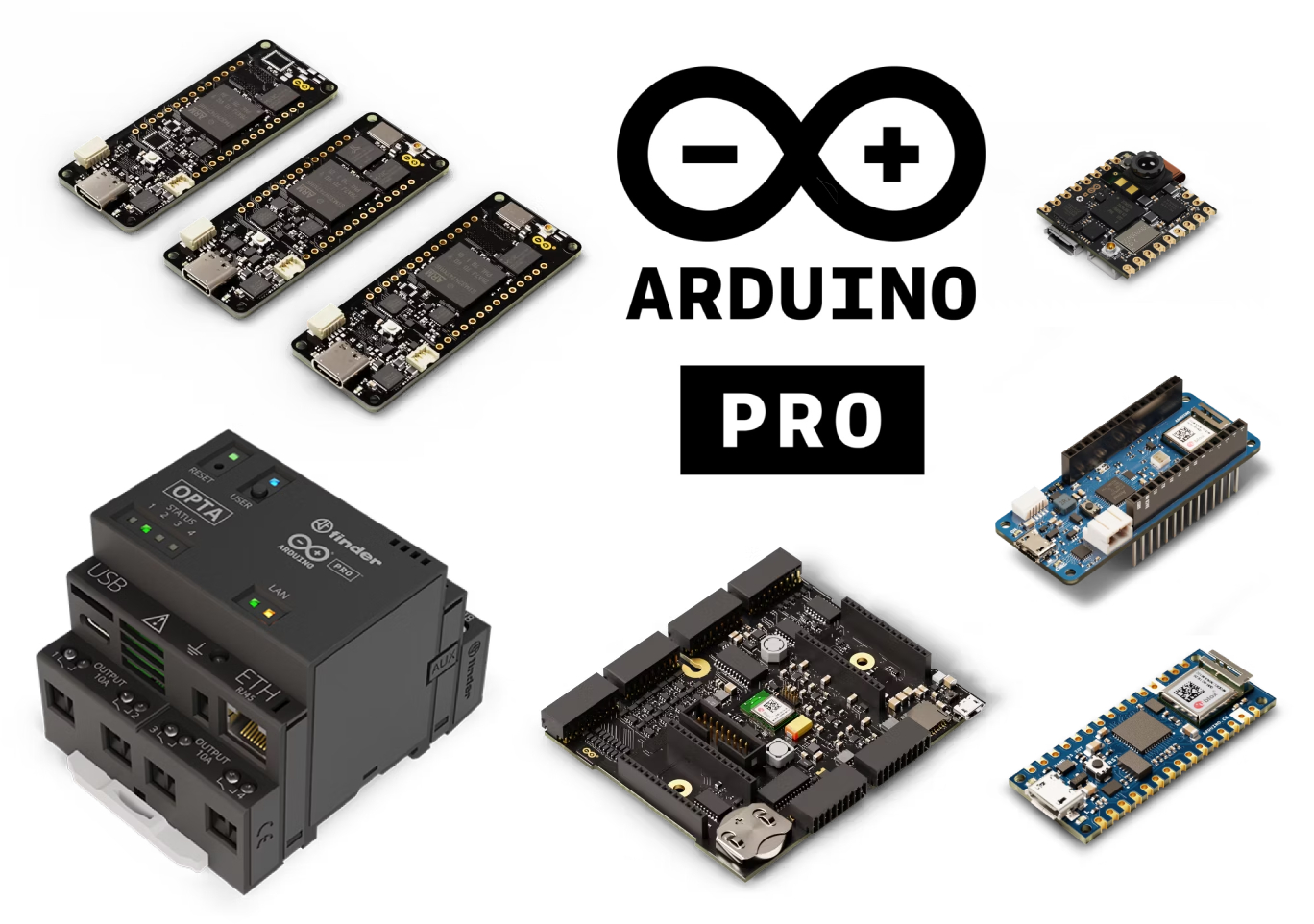Products
Manufacturers
Applications
Following from an interview at Hardware Pioneers Max, which covers the complete Arduino product range on display, please use this temporary user-defined application form to apply to evaluate your choice of Arduino products for use in commercial projects.
If known, please specify the product(s) you are interested in when filling out the form at the bottom of this page with details of your project. As ipXchange writes about more of these products individually, we will expand our Arduino board catalogue with dedicated board pages that cover each product in more technical detail, such as the already-existing page for the Nicla Voice module. A general overview of some of the key Arduino products and product families can be found below, but any available links will take you to the dedicated board page for a full technical overview of the specific product for learning more and applying to evaluate the technology.
Arduino PRO
Arduino’s PRO line of products offers production-ready, certified hardware with a particular focus for use in industrial control, edge-AI processing, and robotics applications. The key products within this line include Arduino’s high-performance Portenta family with industry-grade security, compact Nicla boards for AI-enhanced sensing, the Opta microPLC for Industrial IoT, and Edge Control for agricultural applications; Arduino also produces gateways to support LoRaWAN-connected builds.
Portenta family
Arduino’s Portenta family takes the familiarity of Arduino’s ecosystem and places it firmly at the level of industrial-grade design and security while simultaneously allowing designers to run high-level code for AI/ML-enhanced applications by leveraging a powerful asymmetric core architecture. Unlike most Arduino boards, the Portenta products are also enhanced by 80-pin, high-density connectors with 65 Mbps transfer rate for connecting to expansion boards. There are currently three types of main board in the Portenta range:
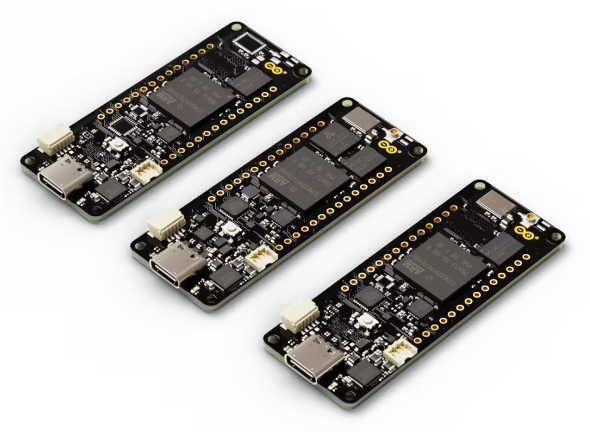
Portenta H7 simultaneously runs high-level code and real-time tasks and is supported by a dual-core MCU that features a Cortex-M7 core at 480 MHz and a Cortex-M4 core running at 240 MHz. A remote procedure call mechanism allows either core to call functions on the other seamlessly to run a variety of workloads and operating systems, including Mbed, Micropython, JavaScript, and TensorFlow Lite. The board also includes Wi-Fi and Bluetooth connectivity to support your application. More information on the H7 devices can be found in this datasheet.
Portenta X8 presents a powerful System on Module (SoM) with 9 processing cores (including 4x Cortex-A53 at up to 1.8 GHz per core, a Cortex-M4 at up to 400 MHz, a Cortex-M7 at up to 480 MHz, and another Cortex-M4 at up to 240 MHz), on-board Wi-Fi and Bluetooth, and a preloaded Linux OS onboard. This plug-and-play solution comes all contained within a compact form factor of just 66.04 x 25.40 mm and features a flexible combination of MCU and MPU functionality to fully support your industrial application. Learn more about this extremely powerful module in this datasheet.
Portenta C33 presents a cost-effective, Cortex-M33-powered board for industrial IoT designs, with Wi-Fi and Bluetooth connectivity, castellated pins for automatic assembly lines, and the industrial-grade security shared by other Portenta products. The on-board connectivity and compatibility with Arduino’s MKR shields make this device a perfect basis for applications that include IoT gateways, remote control systems, fleet management, and process tracking, manageable through over-the-air updates and Arduino Cloud, or third-party services. Learn more in the datasheet here.
The Portenta family also includes turnkey solutions for industrial machine control at low power consumption, breakout boards for easier testing, developing, and debugging, and carrier boards that provide a wide range of physical connectivity options to interface Portenta with the world and other aspects of larger industrial devices. As with many Arduino products, shields for vision and additional connectivity provide a ready-made way to easily add functionality to your design.

And if you’re a Raspberry Pi ecosystem user, Arduino also offers a breakout board in the form of the Portenta Hat Carrier, which can be used with the Portenta X8 to create an industrial-grade single-board computer that is compatible with Raspberry Pi Hats for easy expandability while retaining the familiarity of the Arduino programming ecosystem. For the Portenta H7 and C33, this carrier hat makes it easier to connect to the CAN, ethernet, and USB peripherals when building your project. With the Portenta Hat Carrier, users also gain access to a microSD card slot, JTAG pins for simple debugging, 16x analogue I/Os, an onboard camera connector for machine vision, and a PWM fan connector for thermal management.

The Portenta Mid Carrier offers another alternative platform for fast IoT prototyping and integration of Arduino’s new 4G wireless modules, which are available in an EMEA-focussed model and a Global variant with added GNSS support. It also enables the use of Arduino’s GIGA Display Shield with Arduino’s PRO line of products. Learn more about this carrier and the 4G wireless modules here.

Nicla family
The Nicla family of boards features Arduino’s most compact form factor for industrial-grade designs: 22.86 x 22.86 mm. These highly integrated modules allow developers to easily add low-power AI/ML functionality into their products, working either autonomously via battery power or as part of a wider embedded system. Each of these board features wireless connectivity to support communication in isolation from the rest of a system, and currently, there are three boards within the Nicla family:
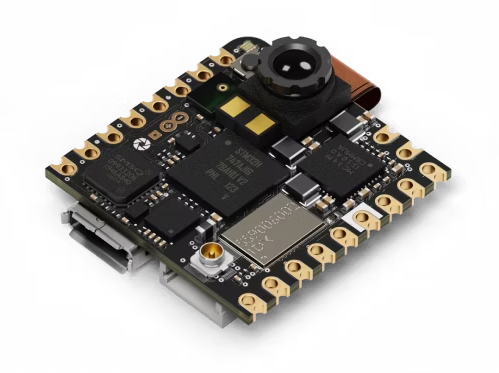
Nicla Vision provides designers with a ready-to-use image processing/analysis platform for AI-enhanced machine vision at the edge. Along with a powerful dual-Arm Cortex processor (M7 core up to 480 MHz + M4 core up to 240 MHz), it features a 2 MPixel colour camera, a 6-axis motion sensor, an integrated microphone, and a distance sensor, enabling products to capture data relating to applications that include asset tracking, image detection, object recognition and predictive maintenance.
Nicla Sense ME (Motion + Environment) features 24/7 always-on sensor data processing at ultra-low power consumption with Bosch Sensortec’s BHI260AP AI-integrated 9-degrees-of-freedom motion sensor, BMM150 magnetometer, BMP390 pressure sensor, and BME688 4-in-1 gas sensor with AI and integrated high-linearity, and high-accuracy pressure, humidity and temperature sensors. On-device AI processing allows designers to reduce latency and power consumption, and the combination of powerful sensors within a single, small module with high compute density presents a wide variety of possibilities in sensor-fusion IoT applications.
ipXchange has already written about the Nicla Voice module – for intelligent voice recognition – in much greater detail on a separate board page here.
Opta
Arduino Opta places Arduino’s industrial-level products into a versatile microPLC developed in partnership with Finder in order to ease the process of scaling-up industrial and building automation projects while retaining the familiarity of the Arduino ecosystem.
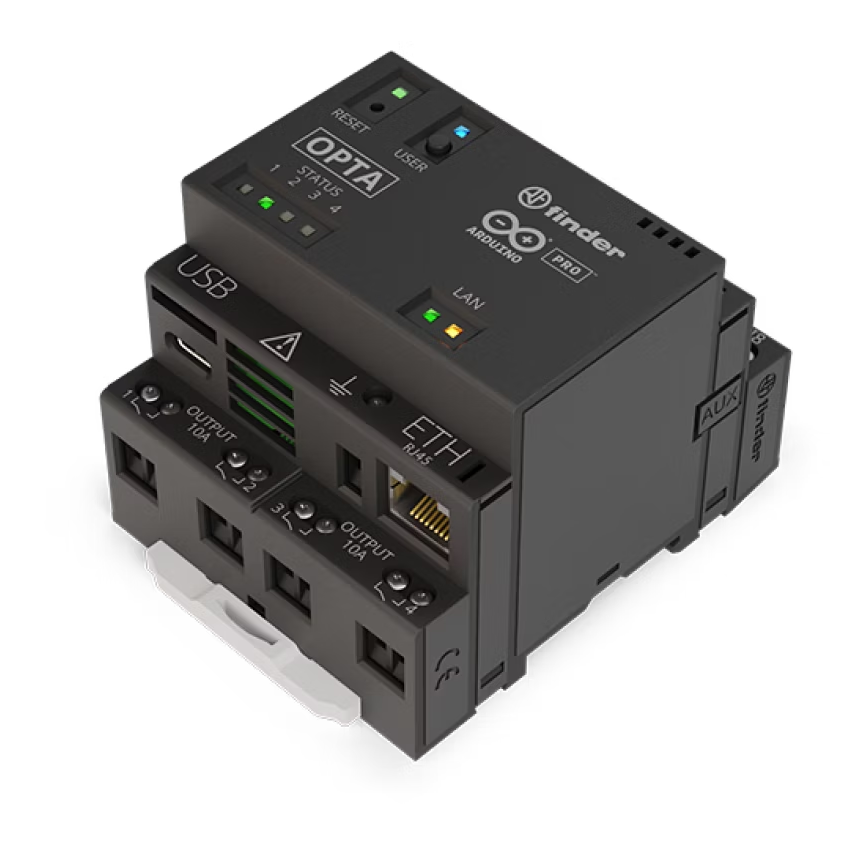
This durable, highly secure module features a dual-core Cortex-M7 + M4 MCU to support real-time control and monitoring for implementing predictive maintenance within industrial IoT applications. A wealth of connectivity options, over-the-air update capabilities, and support for remote real-time dashboards (via Arduino Cloud or another provider) make this module a great solution for installations in hard-to-reach or hazardous locations.
Arduino also offers expansion boards for additional digital and analogue inputs and outputs. These can be easily connected to your main Opta via the auxiliary port, creating a seamless DIN-rail-mountable PLC setup for more complex projects.
For those just getting started with PLC programming, Arduino’s PLC Starter Kit comes with everything you need to start learning with Opta, including two kit-exclusive interface testing boards.
Edge Control
Arduino’s Edge Control provides a remote monitoring and control solution tailored to smart agriculture and other applications in outdoor environments. As well as interfaces for additional sensors, Edge Control can be used to drive actuators, such as latching valves. Power to the board can be supplied using solar panels or DC input, and Arduino Cloud (or an alternative third-party service) provides a user interface for monitoring and controlling the device. Default connectivity options include Bluetooth, with cellular, LoRa, Wi-Fi, and other options available using Arduino’s MKR shields – see below.
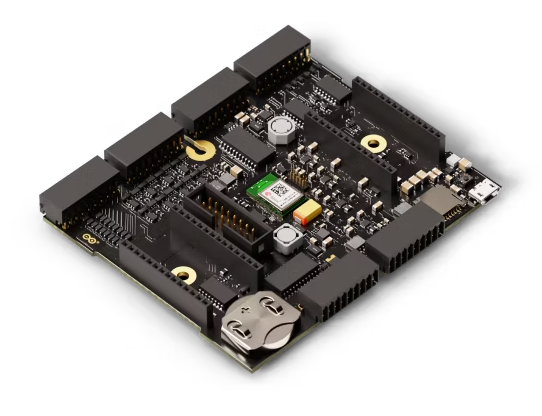
More information about Edge Control can be found in this datasheet.
Arduino MKR
Arduino’s MKR line is an ideal solution of core boards and shields for creating battery-powered IoT products that use a variety of wireless communication protocols, including Wi-Fi and LoRaWAN. These cost-effective boards share a common pinout for easy interchangeability with minimal software rewrites, and serve as intermediate-level devices for building/developing products across a variety of applications.
Arduino Nano
Arduino’s highly reliable Nano-series MCU boards offer designers powerful, AI/ML-capable processing in a compact form factor for light-weight applications such as wearables and drones. Options for a variety of sensors and Bluetooth make these a great core for any project where space is an issue. Recently released ESP32- and RP2040-powered boards make these a perfect starting point for designers already familiar with these popular MCU development environments, and the Nano Every brings the more basic functionality of the original Nano with smaller price tag and the look and feel of the newer products in the line. Pictured below is the Nano 33 IoT, which offers a compact Bluetooth and Wi-Fi solution with a 6-axis IMU for additional functionality. Arduino also produces the Nano Matter for the easiest start with the IoT-unifying wireless protocol that gives it its name.

As previously stated, this board page serves as a summary of Arduino’s product ranges aimed at commercial design engineers. If you are looking to deploy Arduino’s technology in a commercial project simply on the basis of familiarity with their ecosystem, describe your project below, and ipXchange will do our best to connect you with the right person from Arduino to help bring your design to market.
(Product images sourced from Arduino)
